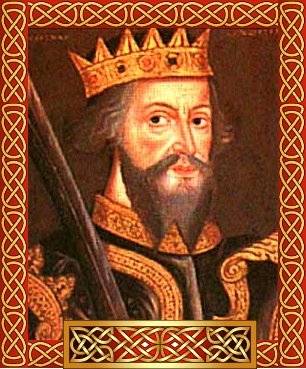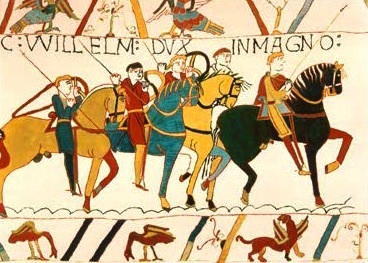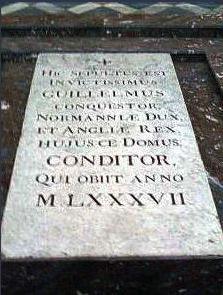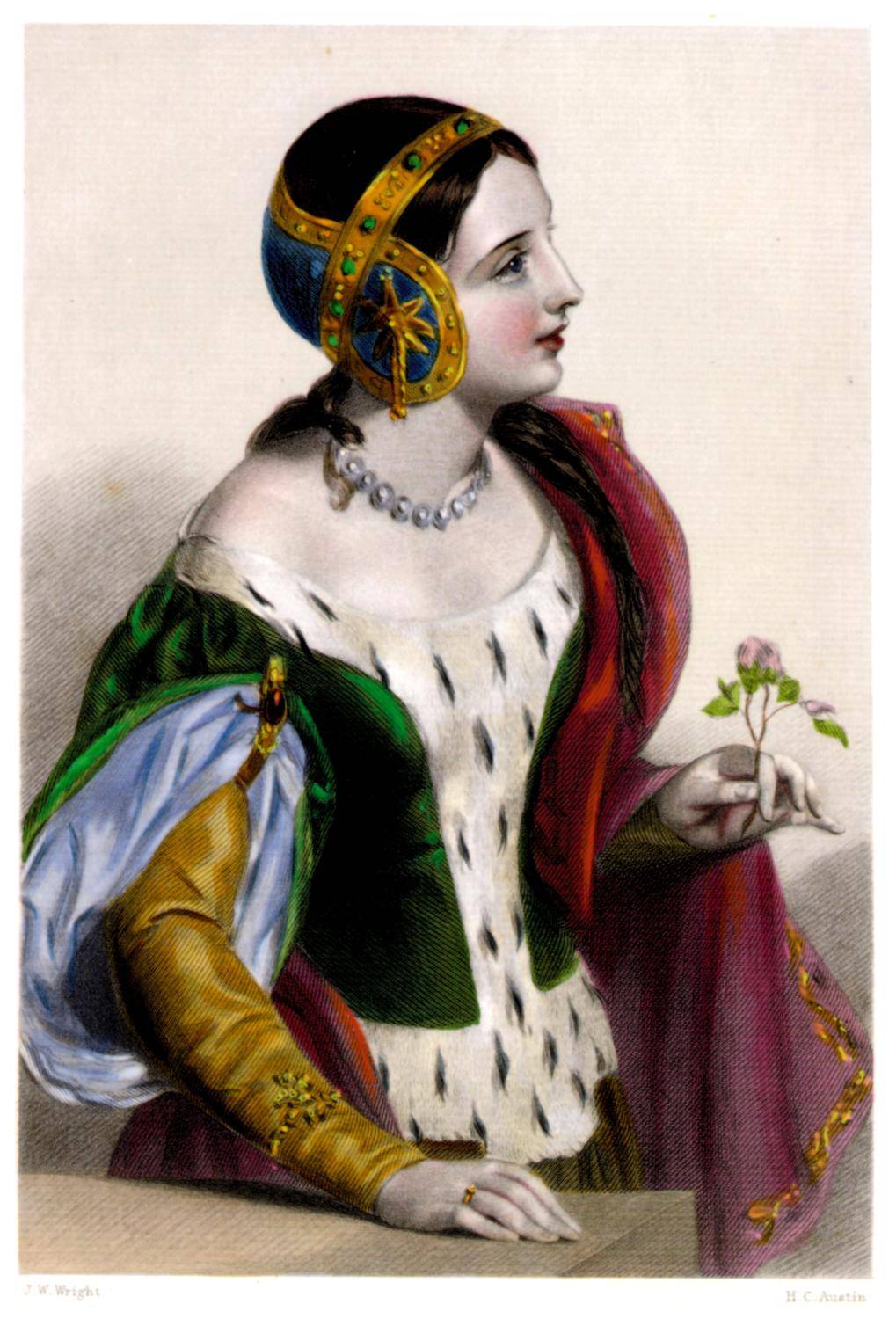Name: King William I The Conqueror
Born: September 1028 at Falaise, Normandy
Parents: Robert I, Duke of Normandy, and Arlette daughter of Fulbert (illegitimate)
Relation to Elizabeth II: 25th great-grandfather
House of: Normandy
Ascended to the throne: December 25, 1066 aged 38 years
Crowned: December 25, 1066 at Westminster Abbey
Married: Matilda, Daughter of Count of Flanders
Children: 4 sons including William II and Henry I, and 6 daughters
Died: September 9, 1087 at Rouen, France, aged 59 years, and 7 days
Buried at: St Stephens Abbey, Caen, Normandy
Reigned for: 20 years, 8 months, and 14 days
Succeeded by: his son William II
William the Conqueror King of England, son of Robert II “The Magnificent” 6th Duke of Normandy and Herleva de Falaise, was born on 14 Oct 1024 in Falaise, Normandy, France and died on 9 Sep 1087 in Hermentrube, Near Rouen, France at age 62. The cause of his death was Fatal fall from a horse. Other names for William were William I King of England, and William. King of England from 25 December 1066. He was the illegitimate son of Duke Robert the Devil whom he succeeded as Duke of Normandy in 1035. Claiming that his 2nd cousin King Edward the Confessor had bequeathed him the English throne, William invaded England in September 1066, defeating Harold II Godwineson at the Battle of Hastings on 14 October 1066.
General Notes:
Reigned 1066-1087. Duke of Normandy 1035-1087. Invaded England defeated and killed his rival Harold at the Battle of Hastings and became King. The Norman conquest of England was completed by 1072 aided by the establishment of feudalism under which his followers were granted land in return for pledges of service and loyalty. King William was noted for his efficient if harsh rule. His administration relied upon Norman and other foreign personnel especially Lanfranc Archbishop of Canterbury. In 1085 started the Domesday Book.
NOTES: William of the House of Normandy; The first Norman King; On 28 Sep 1066 William secured the sanction of Pope Alexander II for a Norman invasion of England. By 1070 the Norman conquest of England was complete. William introduced the Continental system of feudalism; by the Oath of Salisbury of 1086 all landlords swore allegiance to William, thus establishing the precedent that a vassal’s loyalty to the king overrode his fealty to his immediate lord. During a campaign against King Philip I of France, William fell from a horse and was fatally injured. William was the illegitimate son of Robert I, duke of Normandy and Arletta, a tanner’s daughter. He is sometimes called “William the Bastard”.
REF: “Falls the Shadow” Sharon Kay Penman: William requested a large number of Jews to move to England after his conquest. They spoke Norman & did well under his reign.
REF: British Monarchy Official Website: The victory of William I, ‘the Conqueror’ (reigned 1066-1087) at Hastings and his subsequent coronation in Westminster Abbey on Christmas Day 1066 did not give him complete control of England. Remaining resistance was, however, severely crushed and castles were built to control the country (including a fortress on the site of Windsor Castle, and the White Tower at the Tower of London). The lands of defeated Saxon nobles were given to William’s followers in return for military service by a certain number of knights, so that the tenants’ foremost obligation was allegiance to the king. This firmly established the feudal system. In 1086, William commissioned the Domesday Book, to record land holdings for the assessment of taxes and other dues. William spent long periods in Normandy to maintain his authority there, dealing with rebellions and French invasions. William died in 1087 leaving Normandy to his eldest son, Robert, and England to his second son, William II Rufus (reigned 1087-1100).
REF: “Royal Descents of Famous People” Mark Humphreys: Steve Jones’ book “In the Blood: God, Genes, & Destiny” 1996, estimates that 25% of the population of Britain is descended from William the Conqueror. Consider you need two parents, four grandparents, etc. Assuming an average of abt 25 years per generation, you only need go back to 1200, quite within historical times, to need more separate ancestors than the population of the world. Therefor we all must descend from cousin marriages, many times over, even within the last few hundred years. Davenport claimed “no people of English descent are more distantly related than 30th cousins”.
Noted events in his life were:
- Title: 7th Duke of Normandy 1035-1087.
- Military: Invaded Anjou, Brittany, Maine, 1047.
- Military: Norman conquest of England completed by, 1072.
- Personality: Noted for his efficient if harsh rule.
- Political: Started the Domesday Book, 1085.
- Military: Defeated & killed his rival Harold at the Battle of Hastings and became King.
- Title: Reigned as King of England 1066-1087.
William married Matilda of Flanders, daughter of Baudouin V “The Pious” Comte de Flanders and Adela Capet Comtesse de Contenance, in 1053 in Cathedral Of Notre Dame D’eu, Normandy. Matilda was born in 1031 in Flanders, France, died on 2 Nov 1083 in Caen, Calvirginiados, France at age 52, and was buried in Holy Trinity Abbey, Caen, Normandy, France.
Noted events in her life were:
- Political: Served as William’s Regent in Normandy during & after the invasion of England.
Children from this marriage were:
- Adela de Normandy was born in 1062 in Normandy, France and died on 8 Mar 1138 in Marcigny-Sur-Loire, France at age 76.
- Henry I King of England was born about Sep 1068 in Selby, Yorkshire, England and died on 1 Dec 1135 in St. Denis-Le-Fermont, Forest Angers, Near Rouen, Normandy about age 67.
- William II “Rufus” Duke of Normandy, King of England died in 1100.
- Robert II “Curthose” Duke of Normandy died in 1134.
William’s coronation took place in Westminster Abbey on Christmas Day 1066. He completed the establishment of feudalism in England, compiling detailed records of land and property in the Domesday Book, and kept the barons firmly under control. He died in Rouen after a fall from his horse and is buried in Caen, France. He was succeeded by his son William II.
William’s early years were marked by violence and disorder. In 1046 his cousin, Guy of Burgundy, led a revolt which forced the young duke to seek the aid of his overlord, Henry I of France. With Henry’s help, William defeated Guy at Val-és-Dunes, and firmly secured control over Normandy. In 1051–52 William and Henry besieged and captured Domfront castle and Alençon in Maine, France. Almost immediately afterwards, William, Count of Arques, rebelled against the duke with the support of Henry I, who was increasingly concerned about Normandy’s growing power. William quickly besieged the rebel Arques-la-Bataille castle and it was surrendered to him in 1053. In 1054 Henry I and Geoffrey of Anjou invaded Normandy, but the annihilation of part of their force at Mortimer forced them to withdraw. Their second invasion, in 1057, was defeated at Varaville. In 1051 Edward the Confessor had nominated William as heir to the English throne, but when he died in January 1066 Harold (II) Godwinson was crowned. William immediately began preparations for an invasion of England. On 28 September his forces landed unopposed at Pevensey, Sussex. Harold was in the north of England defeating an invasion led by Harald Hardrada, King of Norway, but immediately marched south to meet William. Their armies clashed in the Battle of Hastings on 14 October 1066. Harold was slain and William achieved a decisive victory. In 1067 William forcibly brought southwest England under his control.
In 1068 he marched north and east to establish a number of strategic fortifications. In the summer of 1069 Swein Estrithson of Denmark landed with a considerable force in the Humber and was welcomed by the northern English earls who joined him in expelling the Norman garrison at York. William immediately marched north, destroying everything in his path, and reoccupied York. He undertook a systematic harrying of the north, setting his troops to kill and burn in order to leave nothing that could support future rebellion. The Danish fleet was bought off and departed. In 1072 William led an invasion that forced King Malcolm of Scotland to surrender hostages and swear fealty. In 1073 he was back in France suppressing rebellion in Maine. His regents dealt with a rebellion by the English earls in 1075, and in the latter years of his reign, William twice faced rebellion in Normandy led by his eldest son, Robert (II) Curthose. In 1087 William sacked the French-controlled town of Nantes in the Vexin. In the fighting he suffered a fatal internal injury after being thrown against the pommel of his saddle. He was taken to the priory of Saint-Gervais near Rouen where on 9 September he died.
England’s first Norman king, William I, was born in 1028, at Falaise Castle, the illegitimate son of Robert the Devil or the Magnificent, Duke of Normandy and Herleve, (sometimes called Arlette) the daughter of Fullbert, a tanner of Falaise. Before history renamed him the Conqueror he was more commonly known to his contemporaries as William the Bastard. Herleve was reported to have attracted Duke Robert with her dancing, in some accounts, he is said to have first caught sight of her while she was washing her linen in the castle moat.
The Norman dynasty had been founded by Robert’s ancestor Rollo or Hrolf the Ganger, a Viking raider chief, who was granted the duchy by Charles the Simple, King of France, in 911, at the Treaty of Saint-Clair-sur-Epte, in exchange for feudal alliegiance and conversion to Christianity at which he took the baptismal name of Robert.
William’s mother, Herleve, also had a daughter, Adelaide, to Duke Robert. Although they had a long relationship, the gap in their social standing rendered marriage out of the question and Herleve was married off to one of Robert’s vassals, Herluin, a knight. From this marriage, Herleve produced two further sons, Robert, who later became Count of Mortain and Odo, destined to become Bishop of Bayeux and also to play a part in England’s history.
William, Duke of Normandy
Duke Robert decided to expiate his sins, which were many, by going on pilgrimage in 1034. Since he had no legitimate heir to succeed him, he persuaded his unruly barons to accept the illegitimate William as future Duke of Normandy. On his return journey from the Holy Land Robert died suddenly and the young William succeeded to the Dukedom by his father’s will.
The barons exhibited no loyalty to the”‘base born” child and thereafter William grew up in the school of adversity. He had to learn, very early, how to survive. The barons constantly rebelled and anarchy reigned in Normandy during the years of William’s minority. William’s guardians were murdered in succession. Osbern was killed whilst guarding his door. His maternal uncle, Walter, at one point resorted to hiding the child with some poor people. William was formed and moulded by this savage and insecure childhood into the stark and often ruthless ruler he was later to become.
In 1047, he asserted his authority and crushed the rebels at Val-es-Dunes after which he began to restore order in his Dukedom. At Alencon, the burghers insulted his birth by hanging “hides for the tanner” over the walls. On taking the town he exacted a terrible revenge and had both their hands and feet amputated. One of lifes great survivors, William finally emerged as undisputed Duke of Normandy.
William’s appearance
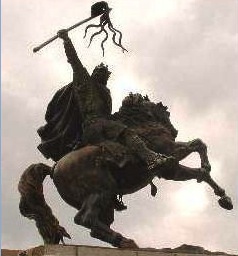 William matured into a tall, thick set man with dark hair, which receeded from his forehead early. His voice was rasping and guttural. William undoubtedly possessed considerable powers of leadership and courage. He was devout and inspired loyalty in his followers, but could also be ruthless and cruel.
William matured into a tall, thick set man with dark hair, which receeded from his forehead early. His voice was rasping and guttural. William undoubtedly possessed considerable powers of leadership and courage. He was devout and inspired loyalty in his followers, but could also be ruthless and cruel.
William of Malmesbury provides us with a detailed description of the king in his Historia Anglorum:-
‘He was of just stature, ordinary corplulence, fierce countenance; his forehead was bare of hair; of such great strength of arm that it was often a matter of surprise, that no one was able to draw his bow, which himself could bend when his horse was in full gallop; he was majestic whether sitting or standing, although the protuberance of his belly deformed his royal person; of excellent health so that he was never confined with any dangerous disorder, except at the last; so given to the pleasures of the chase, that as I have before said, ejecting the inhabitants, he let a space of many miles grow desolate that, when at liberty from other avocations, he might there pursue his pleasures.
His anxiety for money is the only thing on which he can deservedly be blamed. This he sought all opportunities of scraping together, he cared not how; he would say and do some things and indeed almost anything, unbecoming to such great majesty, where the hope of money allured him. I have here no excuse whatever to offer, unless it be, as one has said, that of necessity he must fear many, whom many fear.’
William negotiated a marriage in 1049 to Matilda of Flanders, a descendant of the old Saxon House of Wessex and daughter of Baldwin, Count of Flanders and Adela, daughter of Robert II, King of France. They were an ill-assorted pair, he strongly built and five feet ten inches tall and she ( as it emerged when her skeleton was exhumed) extremely short. It proved however, to be a highly successful union and produced a large family.
The Conquest of England
The Duke of Normandy visited his English cousin, Edward the Confessor, in 1051. Edward and his brother Alfred had spent much of their childhood in exile at the Norman Court, their mother, Emma, had been a daughter of the House of Normandy. During this visit, Edward is purported to have promised his Norman cousin the crown of England, should he die without issue. The real heir was Edgar the Atheling, Edward’s great-nephew, the grandson of his elder brother Edmund Ironside, but he was still a child and knew little of England, having spent much of his life in exile in Hungary. Others also coveted the English throne, the chief candidate amongst these was Harold, son of the powerful Godwine, Earl of Wessex, who’s sister, Edith, was married to King Edward the Confessor..
Harold was unfortunately shipwrecked on the coast of Normandy, where he found himself the unwilling guest of Duke William. The Confessor was now unlikely to survive long and Harold was anxious to return to England to forward his ambitions there. However, before he would allow his guest to leave, William required him to swear an oath to support his claim to the crown upon Edward’s death. Under duress, Harold finally consented and swore the oath on holy relics.
Edward the Confessor finally breathed his last in January, 1066, and was buried in his foundation of St.Peter, Westminster, which had been consecrated but ten days previously. It was reported that on his deathbed he had nominated Harold as his successor who was duly accepted as King by the Saxon Witangemot or council of elders, which traditionally elected the next English King.
Back in Normandy, on receipt of this ominous news, the formidable Duke William flew into a rage. He began to build an invasion fleet to take by force what he considered to be his by right. The Pope himself, due to Harold’s foresworn oath on holy relics, supported William’s enterprise. After Harold was crowned by Archbishop Stigand, a portentous star was seen in the skies, this has now been identified as Halley’s comet, many in that superstitious age saw it as an omen of the wrath of God on the perjured King Harold and his followers.
Harold assembled the fyrdd, the Saxon militia of freemen, in preparation for William’s imminent landing, whilst the Duke prepared his fleet and waited for good weather to set sail for England. In mid September, Harold Hardrada, King of Norway, invaded England, accompanied by Tostig, Earl of Northumbria, Harold’s unruly and discontented brother, who had earlier been banished and his earldom confiscated.
Harold marched his army north in haste to meet the invaders at Stamford Bridge in Yorkshire, where he won a decisive victory over the Viking army. At this time, the winds William had been pensively awaiting turned favourable and he set sail with his massive invasion fleet. News of his landing at Bulverhythe was conveyed to Harold, who responded by hurrying south to meet him, giving his exhausted army no respite. Had Harold rested and reorganized his army, the outcome of the impending battle and English history could have been very different.
On 14th October, the Saxon and Norman forces clashed in the fateful Battle of Hastings. Harold took up a defensive position on Senlac Ridge. The Norman army was thus forced to attack uphill, placing them at a disadvantage.
The Saxon army formed a shield wall along the edge of the hill which rebuffed repeated Norman attacks. A rumour arose in the Norman ranks that Duke William was dead, causing panic and flight. Many of the Saxon fyrdd pursued the fleeing Normans down the hill. William put heart into his army by loudly announcing he still lived. The Normans rallied, Harold’s brothers Gyrth and Leofwine were both slain on the battlefield.
The battle continued for most of the day, Harold and his Saxons fought with steely determination for possession of their country. As dusk began to fall over Hastings, William ordered his archers to fire high into the air and one of these arrows is said to have hit Harold in the eye, blinding him, although this point is disputed by some sources. Whether this was the case or not, Harold fell mortally wounded under the dragon standard of Wessex.
The Saxon army, seeing that the day was lost, began to flee the field. The houscarls, Harold’s trained professional militia, loyally and valiantly defended the body of their King to the last, but they too finally fell and Harold’s body was mutilated by the Normans, a vindictive act, which William punished. The battle was lost and Anglo-Saxon England died with Harold on the battlefield that day.
Harold’s deeply distressed mistress, Edith Swan-neck came to William pleading for her lover’s body and offering him its weight in gold in exchange, but William coldly refused her distraught request. He had Harold buried in a secret location.
William proceeded to London, where he was crowned King of England at Edward the Confessor’s foundation of Westminster Abbey on Christmas Day, 1066.
He accepted the surrender of the Saxon Earls Edwine and Morkere along with that of the child claimant, Edgar Atheling and defeated the heroic Hereward the Wake at Ely. On the whole the south of England submitted to Norman rule, whereas in the north resistance was more prolonged. William responded by subjecting the English to a reign of terror. Determined to punish and crush rebellion to his rule and strike abject fear into English hearts, he laid waste vast tracts of Yorkshire, which suffered under a great famine for nine years after as a result. He rewarded his Norman and French followers by distributing the confiscated lands of the English to them.
William was a savage and formidable ruler, by modern standards an exceedingly cruel one, but his methods produced the desired results and extinguished the fires of opposition. Many castles and keeps were built across the country to enforce his rule, originally wooden towers or earthen mottes, in all over 80 castles were established during the reign, including the White Tower, the first building in the Tower of London complex. The dominating shadow of the White Tower loomed menacingly over medieval London, a visible expression of Norman power.
The new King’s half brother, Odo, Bishop of Bayeux, commissioned a tapestry to commemorate his brother’s victory in 1078. It depicts a series of scenes leading up to and during the conquest. William’s conversion of the New Forest into a royal hunting ground saw the introduction of harsh and severe forest laws, which caused great resentment amongst the Anglo-Saxons. William changed England’s laws and inflicted harsh punishments for offenders. Murder became an officially punishable crime in England and slavery was abolished.
Anglo-Saxon England was radically altered by the Norman conquest, it changed the entire way of life then established in the country. Its laws, aristocracy and church were altered and it introduced the French feudal system. The Anglo-Saxon language was replaced by Norman French as the language of the upper classes, modern English is the natural outgrowth of both. The role of the conquerors and the conquered can still be detected in many English words, the Saxon cow, tended by the lowly Saxon villein became the Norman beef when it appeared on the lord’s table. The Saxon swine became Norman gammon. There are countless other examples in modern English which amply illlustrate the role of Saxon servant and Norman master.
The Norman Feudal System, which William introduced into England, was a complicated heirarchial structure at whose apex sat the king. That lords held their lands under the king in exchange for homage and military assistance rendered to him in times of need.
The Domesday Book
In December, 1085, William decided to commision an enquiry into the extent of his dominions to maximise taxation. This unique survey was known to history as the Domesday Book. The Domesday Book still survives today in the Public Record Office, London and is an extraordinary document for its time.
The Death of William I
The last year of William’s life was spent fighting in Normandy, in battle for the Vexin, a much disputed territory, which lay between Normandy and France. Amongst those opposing him was his rebellious eldest son, Robert, nicknamed Curthose by his father, due to his short legs.
On 9th September, 1087, whilst riding through the smouldering ruins of the sacked town of Mantes, in what must have appeared to him as like an act of divine retribution, William was thrown from his horse when it trod on burning ashes and sustained severe abdominal injuries.
The King, now aged fifty nine and mortally injured, was carried to the convent of St. Gervais in Rouen, the Norman capital. There he summoned his younger sons, William and Henry, to his deathbed. Robert Curthose remained at the court of France. William confessed his sins and sought pardon. His treasure was distributed to the churches and the poor, “so that what I amassed through evil deeds may be assigned to the holy uses of good men.”
England was bequeathed to his second surviving and favourite son, William Rufus and despite his bitter differences with Robert Curthose, he left Normandy to him. To Henry, the youngest son, later destined to inherit all his dominions, he left 5,000 silver pounds. He is reported to have ruminated on and repented of his many sins, transgressions and cruelties at the end. He tried to salve his conscience, before preparing to meet his maker and fearing for his immortal soul, he ordered all the treasure he possessed in Rouen to be given to the church and the poor and forgave his enemies. William the Conqueror died on 9th September, 1087, having ruled England for 21 years.
William was buried in the monastery of St.Stephen at Caen in Normandy, an abbey he had previously founded as an act of repentence for his consanguineous marriage to Matilda of Flanders. The body was broken as it was lowered into the sepulchre, made too short by the stonemasons and the ceremony was interrupted by a dispossessed knight. A stone slab with a Latin inscription, in the abbey church of Caen today marks the burial place of the first Norman King of England. His grave has since been desecrated twice, in the course of the French Wars of Religion his bones were scattered across Caen, and during the tumultuous events of the French Revolution, the Conqueror’s tomb was again despoiled.
House of Normandy Family Tree
The children and grandchildren of William the Conqueror and Matilda of Flanders
(1) Robert ‘Curthose’ Duke of Normandy (1054 -1134) m.Sybilla of Conversano
(i) William Clito, Count of Flanders (d.1128) m. Sybil of Anjou
(2) Richard (circa 1055 – 1081)
(3) WILLIAM II (circa 1056 – 1100)
(4) Cecilia (d.1126)
(5) Adeliza
(6) Adela (circa 1062 – 1138) m. Stephen, Count of Blois
(i) Matilda (d. 1120)
(ii) Theobald, Count of Blois (d. 1151)
(iii) Henry, Bishop of Winchester
(iv)STEPHEN, KING OF ENGLAND (d. 1154) m. Matilda of Boulogne
(v) William
(7) HENRY I (circa 1068 – 1135) m. (i)Edith of Scotland (ii) Adeliza of Louvain
Issue by (i):-
(i)William the Atheling (circa 1103-1128)m. Matilda of Anjou
(ii) MATILDA(circa 1103 – 1162) m. (i) Henry V, Holy Roman Emperor (ii) Geoffrey Plantagenet, Count of Anjou
| Timeline for King William I The Conqueror |
| 1066 | William and his Norman army defeat Harold II and the Anglo Saxons at the Battle of Hastings. Harold is killed and, after subduing the south of the country William is crowned King of England. |
| 1067 | William suppresses a Saxon revolt in the southwest of England. William’s Earls are given lands driving out the Anglo Saxon lords. Norman French becomes the language of government. |
| 1068 | William puts down a revolt in the northern counties led by Edwin and Morcar and establishes fortifications. The region is laid waste in an action known as ‘Harrying the North’. |
| 1069 | Swen Estrithson of Denmark lands in the Humber and is welcomed by northern English earls who join him in expelling the Norman garrison at York. William marches north and reoccupies York |
| 1070 | Hereward the Wake leads a revolt against the Normans. |
| 1071 | William defeats the revolt led by Hereward the Wake in East Anglia, thus putting an end to Saxon resistance to his rule. |
| 1072 | William invades Scotland and compels Malcolm III to pay homage to him. |
| 1073 | Suppresses rebellion in Maine in France |
| 1078 | Work begins on the Tower of London |
| 1079 | William begins the construction of a Norman Cathedral at Winchester. |
| 1079 | Robert, William’s eldest son, leads a rebellion in Normandy, but is defeated by his father at the Battle of Gerberoi and his life is spared. |
| 1085 | William orders a survey of the shires of England; the information is recorded in the Domesday Book, which is completed the following year. |
| 1086 | William writes to the Pope that England owes no allegiance to the Church of Rome |
| 1086 | Domesday survey of England completed |
| 1087 | William dies of his injuries after falling from his horse while besieging the French city of Nantes. |
Credits:
http://www.englishmonarchs.co.uk/
http://www.britroyals.com/

